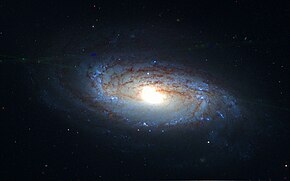
Summary
NGC 5806 is an intermediate spiral galaxy in the constellation Virgo. It was discovered on February 24, 1786, by the astronomer John Herschel.[4] It is located about 70 million light-years (or about 21 Megaparsecs) away from the Milky Way.[3] It is a member of the NGC 5846 Group.[2]
| NGC 5806 | |
|---|---|
 NGC 5806, as observed by the Hubble Space Telescope (HST). | |
| Observation data (J2000 epoch) | |
| Constellation | Virgo |
| Right ascension | 15h 00m 00.400s[1] |
| Declination | +01° 53′ 28.70″[1] |
| Redshift | 0.00450[2] |
| Heliocentric radial velocity | 1346 ± 21 km/s[2] |
| Distance | 68 Mly (21 Mpc)[3] |
| Apparent magnitude (V) | 11.70[3] |
| Apparent magnitude (B) | 12.40[3] |
| Characteristics | |
| Type | SAB(s)b[1][3] |
| Apparent size (V) | 3.1′ × 1.6′[3] |
| Other designations | |
| UGC 9645, MCG +00-38-014, PGC 53578[2] | |
NGC 5806 contains a star that was catalogued as a supernova (SN Hunt 248), but turned out to be a supernova imposter. The progenitor was detected as a cool hypergiant with an absolute visual magnitude of −9 and 400,000 times more luminous than the sun. The eruption saw it increase in luminosity to around 80,000,000 L☉.[5]

NGC 5806 has also hosted several true supernova. SN 2004dg, around 100 times brighter than SN Hunt 248 was a typical type II supernova. The progenitor has not been detected and is expected to have been a relatively low mass, low luminosity, red supergiant.[6] PTF12os in 2012 was a type IIb supernova that occurred in 2012, and iPTF13bvn was a type Ib supernova that exploded in 2013.[7]
References edit
- ^ a b c "Results for object NGC 5806 (NGC 5806)". NASA/IPAC Extragalactic Database. California Institute of Technology. Retrieved 2021-02-21.
- ^ a b c d "NGC 5806". SIMBAD. Centre de données astronomiques de Strasbourg. Retrieved 2021-02-21.
- ^ a b c d e f Gil de Paz, Armando; et al. (December 2007). "The GALEX Ultraviolet Atlas of Nearby Galaxies". The Astrophysical Journal Supplement Series. 173 (2): 185–255. arXiv:astro-ph/0606440. Bibcode:2007ApJS..173..185G. doi:10.1086/516636. S2CID 119085482.
- ^ Seligman, Courtney. "New General Catalogue objects: NGC 5800 - 5849". cseligman.com. Retrieved 2021-02-21.
- ^ Mauerhan, Jon C.; Van Dyk, Schuyler D.; Graham, Melissa L.; Zheng, Weikang; Clubb, Kelsey I.; Filippenko, Alexei V.; Valenti, Stefano; Brown, Peter; Smith, Nathan; Howell, D. Andrew; Arcavi, Iair (2015). "SN Hunt 248: A super-Eddington outburst from a massive cool hypergiant". Monthly Notices of the Royal Astronomical Society. 447 (2): 1922. arXiv:1407.4681. Bibcode:2015MNRAS.447.1922M. doi:10.1093/mnras/stu2541. S2CID 11415725.
- ^ Smartt, S. J.; Eldridge, J. J.; Crockett, R. M.; Maund, J. R. (2009). "The death of massive stars - I. Observational constraints on the progenitors of Type II-P supernovae". Monthly Notices of the Royal Astronomical Society. 395 (3): 1409. arXiv:0809.0403. Bibcode:2009MNRAS.395.1409S. doi:10.1111/j.1365-2966.2009.14506.x. S2CID 3228766.
- ^ Fremling, C.; Sollerman, J.; Taddia, F.; Ergon, M.; Fraser, M.; Karamehmetoglu, E.; Valenti, S.; Jerkstrand, A.; Arcavi, I.; Bufano, F.; Elias Rosa, N.; Filippenko, A. V.; Fox, D.; Gal-Yam, A.; Howell, D. A.; Kotak, R.; Mazzali, P.; Milisavljevic, D.; Nugent, P. E.; Nyholm, A.; Pian, E.; Smartt, S. (2016). "PTF12os and iPTF13bvn". Astronomy & Astrophysics. 593: A68. arXiv:1606.03074. doi:10.1051/0004-6361/201628275. S2CID 54028503.
External links edit
- Media related to NGC 5806 at Wikimedia Commons
- An LBV masquerading as a cool hypergiant
- ESA/Hubble Picture of the Week showing SN 2004dg


